Dear Steemians, as I promised you I will now provide you with some facts about Egyptology and my recent research on lion's sculptures. In this article, you will explore the Temple of Medinet Madi together with me. I visited the site in winter 2017 for a scientific paper on the iconography of lions in the oases of Egypt. Studies in iconography are a part of the daily egyptological work deriving from the History of Arts. We select, describe, analyse and compare objects of the same category and/or parts of them in a certain way which allows us to draw conclusions for scientific questions like What is the origin of the expression? Which other cultures may have influenced the "artist"? Can we re-draw possible ways of traditioning – maybe by identifying trade routes or even warlike conflicts as the cause of the adoption of stylistic features? You will get a short introduction into my motivation for this research before I show you one of the most impressing temples of the Fayoum Oasis in Egypt.
I) A few words about Egyptian Art
As you may notice, in the previous paragraph I wrote "artist" in quotation marks. This means that this term is not to be taken literally. In the ancient egyptian culture we are often confronted with a huge amount of artistic workpieces, but we cannot be sure if the reason why they were created had an artistic background. The motivation behind egyptian drawings and sculptures is complex. Their motifs vary from a deep desire to manifest their believing in an eternal afterlife by the magical function of a fixed picture on the wall to a will to support the Pharao's strategy to maintain stability in the country by showing his war power to potential enemies on reliefs at the walls of his palace. "Art" in the basic meaning can have this message, too, but the freedom in its expression is different. The Egyptians had, for example, a specified arrangement of architectural elements in their temples, the so-called "Grammaire du temple"1. This means that the orientation of the temple and the elements within the temple, as well as the layout of the reliefs and drawings, follow a fixed scheme that underwent only a few changes during the centuries. For example: in most cases, the pictures were sorted in registers separated by vertical or horizontal lines. There were never "chaos" in the design of a complete wall because this would have felt for an Egyptian like a deep conflict to his sense of harmony, also called the Ma'at.
There are a lot of theories around the artistic quality of Egyptian drawings and three-dimensional objects but I don't want to bore you with it. The only thing I want you to kepp in mind is the "inner limits" of egyptian craftsmen or even "artists" they were bound to when they created a picture or a sculpture.
II) The Lion in Egyptian History
The lion played a big part in the iconography of the ancient egyptian world. He was not only a symbol for the Pharao's power but also connected with the solar cycle that represented the re-birth of the Sun God. This was a central point in the reality of all Egyptians who aimed for renewing and a good life in the hereafter. So we can find a lot of lion's remains in the sands – as objects, drawings, in texts, in people's or Gods names and even as physical remains of real animals in temples like Leontopolis – an ancient city of the Graeco-Roman period in the delta where the Lion God Mahes (son of the Lion Goddess Bastet) was worshipped. We know now today that living lions were held in captivity within the temple's area2 and buried in the vicinity.
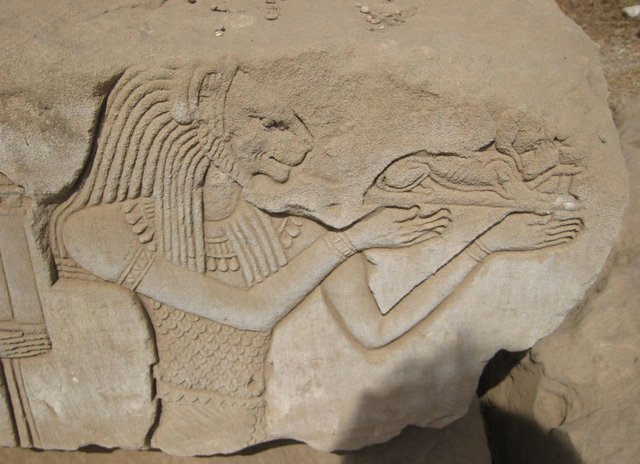
Mahes from a Ptolemaic relief, Picture: CC BY-SA 2.0, 
In accordance with the solar symbolism as mentioned above the lion often was depicted twice. He appeared as a pair in the shape of the Gods Shu and Tefnut, that stood for the beginning and the end of the solar cycle. So we can find pictures of lions especially on entrances, left and right to the door, or as guardian lions in a row looking at each other, for example, like in the well-known sphinx avenues in front of ancient egyptian temples. The Sphinx is a special expression of the lion and often depicts the Pharao himself: the lion's body is strong, full of well-defined muscles and tendons, huge round paws and – sometimes very prominent testicles, while the head was often that of a human with royal attributes like the nemes scarf and a ceremonial beard.
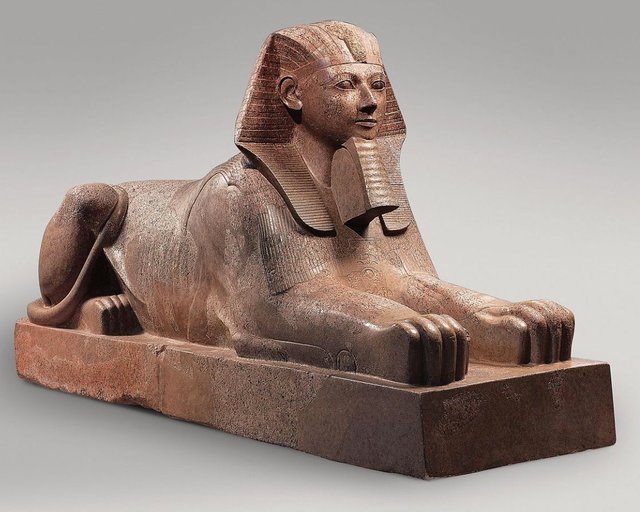
Did you know that even female leaders showed themselves as lions with male attributes? Here is a picture of the Queen Hatshepsut from Deir el-Bahari, Picture: Public Domain by Metmuseum New York, https://www.metmuseum.org/art/collection/search/544442.
We know also of lion hunting spectacles that were the Pharao's privilege to show up in front of his people as a strong leader who can defy and conquer the wilderness and bring the country forward.
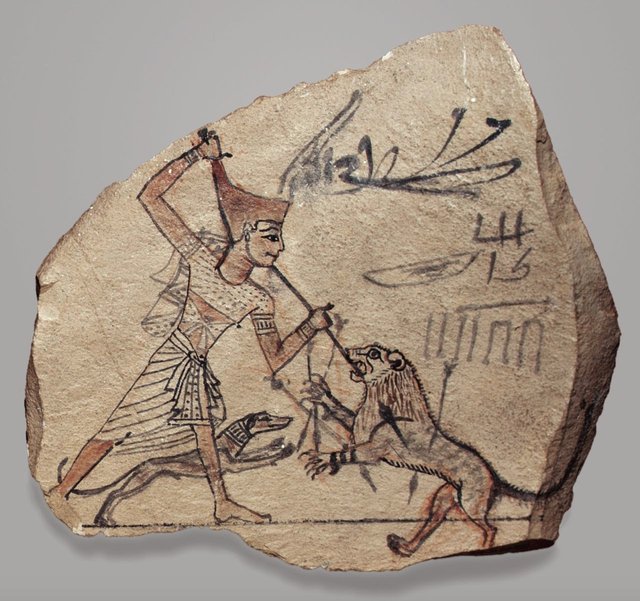
Here you see a so-called ostracon, an ancient sketchbook, with an (unknown) Pharao killing a lion, Picture: Public Domain, Metmuseum New York, https://www.metmuseum.org/art/collection/search/544076.
III) Lions in the Oases
My recent research focused on the iconography of lions in the oases of Egypt. Oases are different from the rest of the country which is mostly characterized by a landscape shaped by the river Nile that feared and nurtured the population at the same time. The life in a place in the desert requires the adaption to different environmental circumstances. While there is no annual flooding that threatens the life of the people, the isolation is the basic challenge here. That's why oases are often called "desert islands"3. The lion as an animal is not a typical "desert animal" since the optimal food cannot be found there but mostly in the so-called wadis which are dried out riverbeds or valleys – often close to human settlements. Wild lions, hungry were feared by the people.
My aim was to collect and describe as many as possible pictures and sculptures of lions in the oases, to find out if there are also differences in their iconography which a) can be clearly distinguished from the iconography of lions from the Nile and b) maybe show evidence of an african influence from the south – because the (african) lion's home is mainly to be located in the southern.
Unfortunately, these theories could not be validated – at least not at this time. There is no visible proof of a picture of the african lion that could have served as a model for the oases lions. Although there are some strong elements that characterize the african iconography (for example the roaring lion, often found in Nubian temples (today: Sudan) with an open mouth and an aggressive look is usually not part of the egyptian style), we mostly find those adoptions in temples along the Nile but not in the oases. Beside this, the iconography of the oases lions doesn't differ from the rest of the country. We can find mediterranean influences as well as stylistic features from other geographical regions like Jordan or Syria.
Although this might seem a bit unsatisfying from a scientific perspective, this is a common conclusion in the humanities. The interpretation of the iconographical elements depends on many factors and in the end its a decision of evidence based on the archaeological experience of a researcher.
I studied lions in five oases: Fayoum, Siwa, Bahariya, Kharga and Dakhla. In this article, I chose to show you one of the most amazing archaeological sources for this study: the Lion's Temple at Medinet Madi. If you like to have further information about the other sources, for example, the depicting of lions and lion-like furniture in the Hibis Temple of the Kharga Oasis, let me know.
IV) The Lion's Temple at Medinet Madi
This sacred area is a little secret hidden far deep in the Oasis Fayoum which is an untypical oasis because it is not an isolated place but connected with the river Nile by a canal. For more information about the Fayoum feel free to read my article about Fayoum.
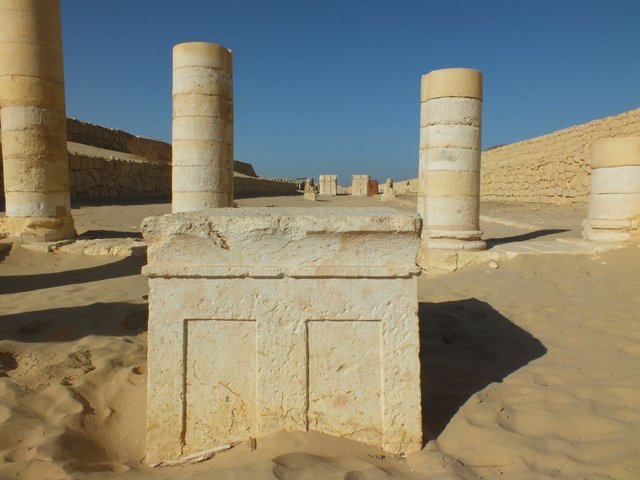
Entrance to the temple with a long dromos (processional way), Picture: own work, 2017.
The temple was built in the Middle Kingdom (2137–1781 BCE) to worship the Gods Sobek (male crocodile) and Renenutet (female snake). So it was not an original lion temple. Egyptologists haven't found remains of living lions there but that of a crocodile nursery with eggs and eggshells of baby crocodiles. The name "lion temple" was given to the site by archaeologists who excavated an additional part of the temple that was built later in the middle of the 2nd century by Ptolemaios VIII and Ptolemaios IX and revealed a huge amount of lion sculptures and sphinxes of different shapes. The archaeologist Achille Vogliano first saved a few of the statues between 1936–1939 and brought them to the Graeco-Roman Museum in Alexandria4. The work had to be interrupted by the second world war and could be continued by archaeologists of the University of Pisa in the late 60s, leading to the publication of Bresciani and Giammarusti5.
Here are now a few of the most impressive statues with some explanations of their specialities:

A pair of recumbent lions at the entrance to the vestibule, Picture: own work, 2017.
These two lions appear to be friendly looking and welcoming the visitor. But with a closer look and compared with similar "resting" lion's sculptures there are a few fine details that can lead to a different conclusion. Especially the position of the tail has here a significant meaning. If you observe lions – or simply your domestic cat at home – you will probably know that the tail can reveal the true mood of the animal. The obvious resting position here is deceiving! One of the typical cat's habit is not to show the tension it is feeling by watching new visitors coming. On the surface, it is able to show all kinds of mood from pretending to be bored to a "poker face". A really resting lion who doesn't expect any danger puts his tail on his flank. The complete body is resting including the tip of the tail lying on his back, as you can see in some of the following pictures for comparing. In those cases also the paws are bent over. A lion at the entrance to a sacred place instead has a special function: he protects the holy area by being ready to jump and attack in case of danger. So this both animals here – although looking inviting – will not hesitate to prevent you from coming by all means in if your intentions contrary to the religious customs and behaviours of the temple.

A second pair of lions also at the entrance but in a higher position, Picture: own work, 2017.
This second pair shows the differences mentioned before. Here you can see clearly the position of the tail that is resting on the lion's back. Although also this pair of lions is not really resting because of their raised bodies lying on their paws they are positioned at the top of the wall surrounding the sacred area and looking straight forward to the main entrance. They seem to be scouts like on an observation tower who are not directly in danger by themselves when danger is coming from far away.

Detailed view of the flanks and paws of a lion sculpture, Picture: own work, 2017.
Here you can see a picture of a lion sculpture that is part of a pair arranged opposite in direction to each other and guarding the dromos (processional way) together with many other lions and sphinxes. It is interesting, that the paws and the flanks are precisely shaped here. This is a more naturalistic style in statues that may be based on the craftsmen's knowledge. He probably was familiar to the real look of a lion. There are several scientific opinions about the question if the people who created such statues ever have seen a lion in reality. Doubts about that occur usually in those cases where the statue lacks details or shows features that can not be found in the original animal.

Detailed view of the testicles (left side) and sharp paws (right side) of a lion sculpture, Picture: own work, 2017.
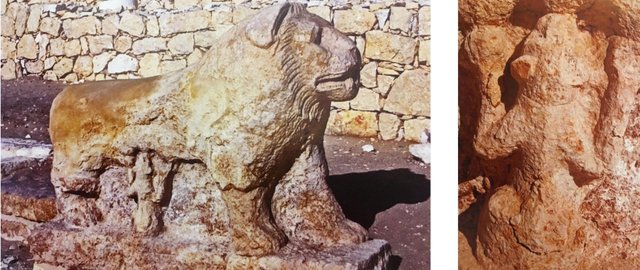
Lioness with suckling cubs, Picture: Alberto, Siliotti (Ed.), Medinet Madi, Archaeological Guide, Verona 2010, pp. 27.
An extraordinary example that shows the variety of the style of lion statues in this temple is that of a lioness suckling her cubs. Not only the open mouth with the sharp teeth is very unusual for the egyptian style in general. But also the fact that this is obviously a female lion – but has a huge mane – is a feature worth having a closer look! However, this feature of male attributes at female lions is quite common. Especially lion Goddesses (not to mix up with cat Goddesses) often have a mane. The reason for this is controversially discussed, but in my opinion, the mane around the head is working as a trait to distinguish a depiction of a lion from other similar animals like hyena or dogs.
V) Summary
I hope I was able to give you a brief introduction to the fascinating world of lion sculptures. In my eyes, they are not just "dead stones". With a closer look, you can discover their stories behind even if they don't "talk" to us - for example in inscriptions. The sculptures of Medinet Madi have only a few inscriptions, mostly some private dedications to a God or Goddess written in Ancient Greek language. But their features, positions, facial expressions - shortly their "body language" is quite meaningful and opens more questions about the function and symbolism of lions in Ancient Egypt, not only in the oases but in general.
What do you think about it? And what is your feeling when you look at an old egyptian statue – maybe of a lion or something else: do they TALK? ;)
Sources:
- https://www.ucl.ac.uk/museums-static/digitalegypt/temple/reading.html.
- Long, George, The British Museum: Egyptian Antiquities, Vol. I, London 1832, p. 229.
- Herodot 3.26.1; Morris, Ellen F., Insularity and Island Identity in the Oases Bordering Egypt's Great Sand Sea, in: CASAE 42, 127–142, p. 128.
- Vogliano, Achille, Un'impresa archeologica milanese ai margini orientali del deserto libico, Mailand 1942.
- Bresciani Edda / Giammarusti, Antonio, I templi di Medinet Madi nel Fayum, Pisa 2012.
Further reading
- Giddy, Lisa L., Egyptian Oases: Bahariya, Dakhla, Farafra and Kharga during Pharaonic Times, Warnminster 1987.
- Müller, Hans Wolfgang, Löwenskulpturen in der Ägyptischen Sammlung des Bayrischen Staates, Münchner Jahrbuch der bildenden Kunst, 3. Folge, Band 16, München 1965.
- Schweitzer, Ursula, Löwe und Sphinx in alten Ägypten, Glückstadt 1948.
Licenses of the Pictures are CC BY-SA 3.0 or CC BY-SA 4.0 with the corresponding author credited appropriately below the picture or my own work. Image used in the editorial picture: https://pixabay.com/de/photos/löwe-raubtier-gefährlich-mähne-3040797/
If you liked this article, please follow me on my blog @laylahsophia. I am a German Egyptologist writing about ancient and contemporary Egypt, history of science, philosophy and life.

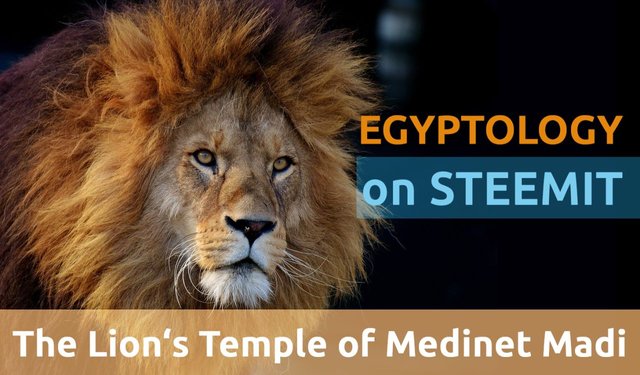
This post has been voted on by the SteemSTEM curation team and voting trail in collaboration with @utopian-io and @curie.
If you appreciate the work we are doing then consider voting all three projects for witness by selecting stem.witness, utopian-io and curie!
For additional information please join us on the SteemSTEM discord and to get to know the rest of the community!
Downvoting a post can decrease pending rewards and make it less visible. Common reasons:
Submit
I am so happy to read from you again. It was a so long time (maybe a year or so). And the first thing I read concerns your own research work. This is great and I wish I read more post from researchers and their actual research on Steem.
How are things by the way? Are you still investigating the potential differences in Lions from different Egyptian places (oases/Nile region)? Have you found anything new in the meantime?
Downvoting a post can decrease pending rewards and make it less visible. Common reasons:
Submit
Thank you so much for your kind words! Yes, it was quite a long time since I was active here. And a lot of things happened. That's why I am not working at the moment, because I am preparing to become a Mum. :))
Downvoting a post can decrease pending rewards and make it less visible. Common reasons:
Submit
Congratulations on this! When is the future D-Day? :)
Downvoting a post can decrease pending rewards and make it less visible. Common reasons:
Submit
It‘s in May. 💗🌸
Posted using Partiko iOS
Downvoting a post can decrease pending rewards and make it less visible. Common reasons:
Submit
2 months to go!! It starts to be really really close.
May I also ask something very naive? It seems that you stopped working pretty late in your pregnancy. Wasn't going to the desert to do the kind of work you do with a big belly too difficult?
Downvoting a post can decrease pending rewards and make it less visible. Common reasons:
Submit
Hello laylahsophia, welcome to Partiko, an amazing community for crypto lovers! Here, you will find cool people to connect with, and interesting articles to read!
You can also earn Partiko Points by engaging with people and bringing new people in. And you can convert them into crypto! How cool is that!
Hopefully you will have a lot of fun using Partiko! And never hesitate to reach out to me when you have questions!
Cheers,
crypto.talk
Creator of Partiko
Downvoting a post can decrease pending rewards and make it less visible. Common reasons:
Submit
Your second image isn't displaying correctly for me.
Downvoting a post can decrease pending rewards and make it less visible. Common reasons:
Submit
But it does seem to display very nicely on steemstem.io... So .. I guess its all good :D
Downvoting a post can decrease pending rewards and make it less visible. Common reasons:
Submit
Congratulations @laylahsophia! You have completed the following achievement on the Steem blockchain and have been rewarded with new badge(s) :
You can view your badges on your Steem Board and compare to others on the Steem Ranking
If you no longer want to receive notifications, reply to this comment with the word
STOPDo not miss the last post from @steemitboard:
Vote for @Steemitboard as a witness to get one more award and increased upvotes!
Downvoting a post can decrease pending rewards and make it less visible. Common reasons:
Submit
Hi @laylahsophia!
Your post was upvoted by Utopian.io in cooperation with @steemstem - supporting knowledge, innovation and technological advancement on the Steem Blockchain.
Contribute to Open Source with utopian.io
Learn how to contribute on our website and join the new open source economy.
Want to chat? Join the Utopian Community on Discord https://discord.gg/h52nFrV
Downvoting a post can decrease pending rewards and make it less visible. Common reasons:
Submit